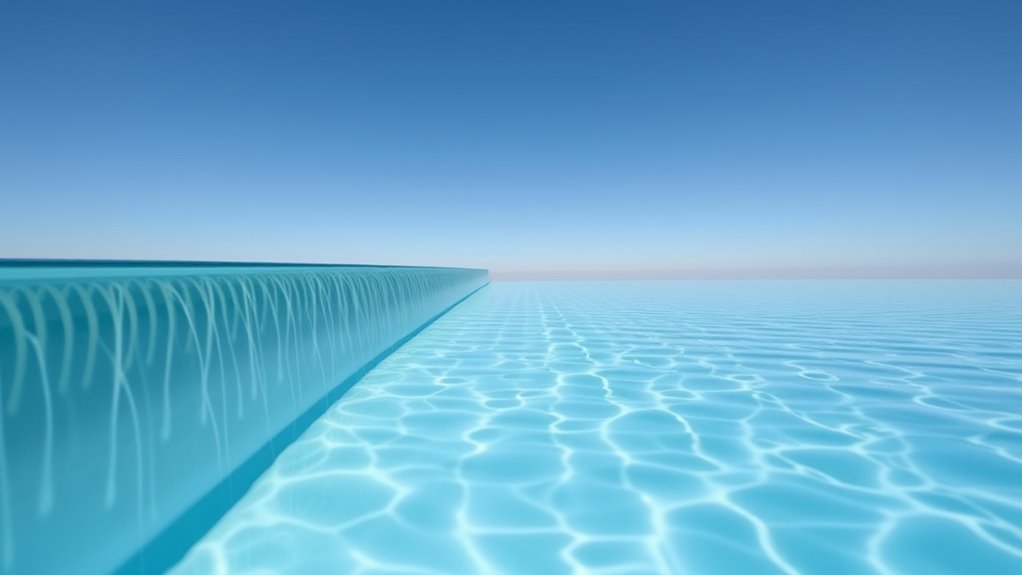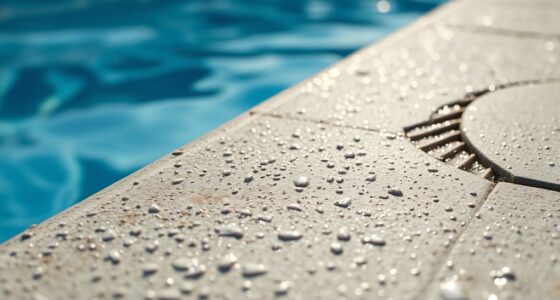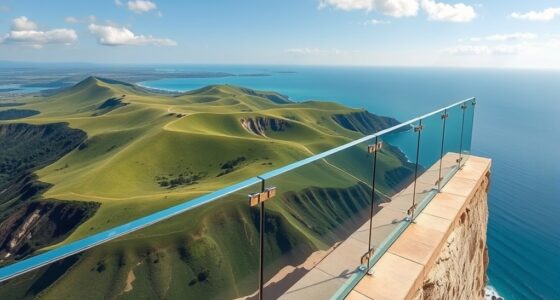A vanishing-edge pool relies on three key components: the weir, trough, and surge tank, which work together to create the seamless water illusion. The weir controls water flow, maintaining a steady level and filtering debris, while the trough guides water smoothly to the catch basin or surge tank. The surge tank stabilizes water levels and manages fluctuations. Understanding how these parts interact ensures the pool looks stunning and functions reliably; continue to explore how each plays a crucial role.
Key Takeaways
- The weir controls water flow over the edge, maintaining a consistent water level and filtering debris.
- The trough channels water from the weir to the catch basin, ensuring smooth, turbulence-free spillover.
- The surge tank buffers water level fluctuations, preventing overflow and maintaining system stability.
- Together, these components create the seamless water edge illusion and ensure efficient water circulation.
- Proper design and maintenance of the weir, trough, and surge tank are essential for pool performance and aesthetic appeal.
Understanding the Basic Design of Vanishing-Edge Pools
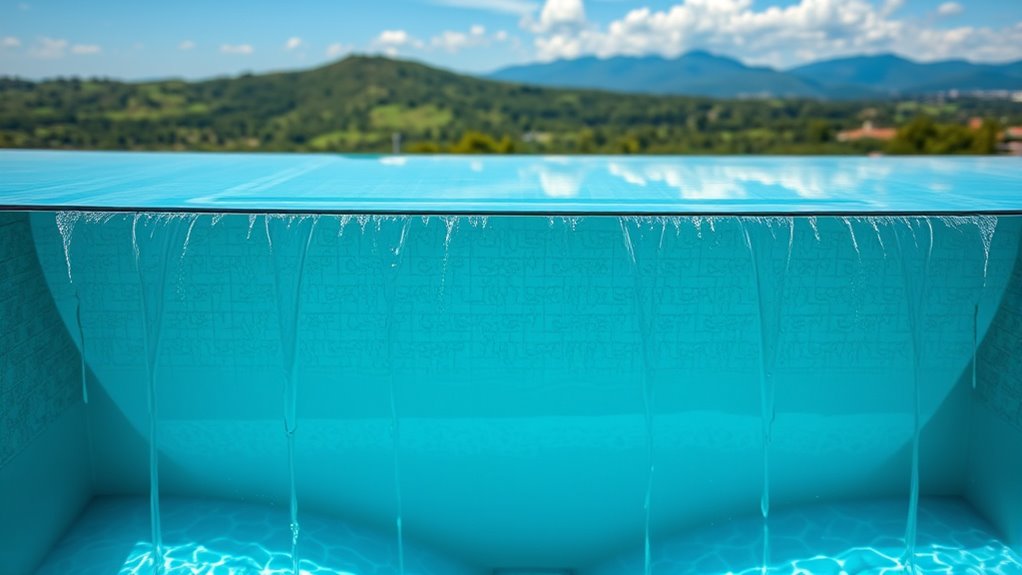
Vanishing-edge pools, also known as infinity pools, are designed to create the illusion that the water extends seamlessly into the horizon. To achieve this, you’ll notice a water level that’s carefully calibrated to be even with the edge. The pool’s rim is built slightly lower than the water surface, allowing water to spill over evenly. This spillover is collected in a catch basin hidden below the edge. The design relies on precise construction to maintain the visual effect, with the pool’s shape often rectangular or freeform to complement the surrounding landscape. You’ll see that the edge is usually flush with the water surface, emphasizing the seamless connectivity. This basic design combines aesthetic appeal with clever engineering to produce a stunning visual experience. Proper water level calibration ensures the illusion remains flawless and enhances the overall visual impact.
The Role and Function of the Weir in Water Management

Have you ever wondered how the water flows smoothly over the edge of an infinity pool? The weir plays a vital role in this process. It acts as a barrier that controls water flow, guaranteeing a consistent, even level in the pool.
The weir ensures smooth water flow and a flawless infinity edge.
Here’s how it works:
- The weir maintains a steady water height by allowing excess water to spill over at a controlled rate.
- It prevents debris from entering the main pool, filtering out leaves and dirt.
- By regulating flow, it guarantees the water moves smoothly toward the trough without turbulence, creating the seamless visual effect.
Without the weir, water levels would fluctuate, and the stunning infinity edge would lose its clean, elegant appearance.
How the Trough Supports the Infinity Effect
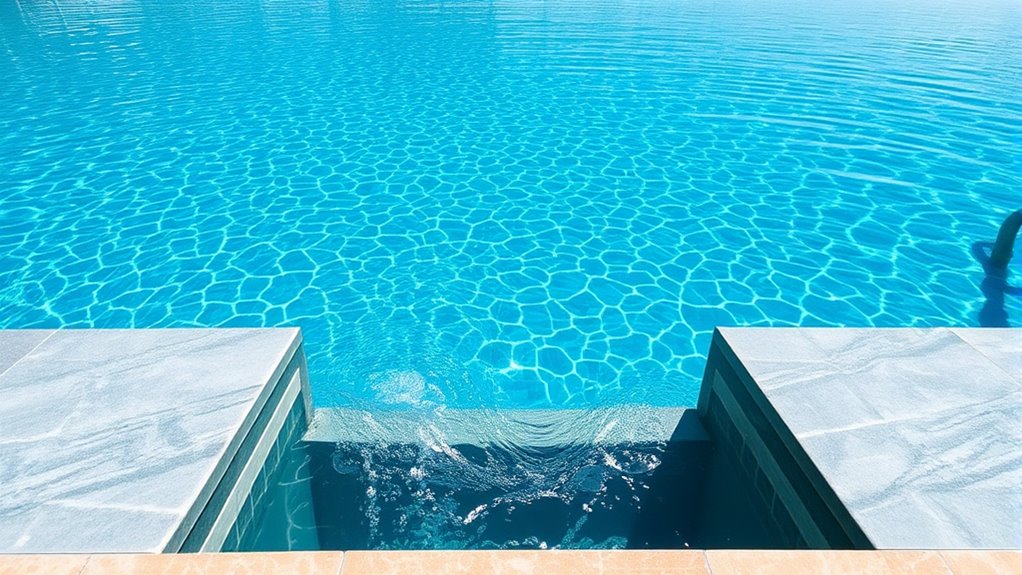
The trough is the key element that creates the illusion of an endless water horizon. It guides water smoothly from the main pool to the catch basin, guaranteeing a continuous flow without visible gaps. When water flows over the weir, it enters the trough, which acts as a channel that maintains a consistent, even level. This steady flow minimizes splashing and turbulence, enhancing the seamless appearance. The trough’s design ensures that water moves silently and uniformly, reinforcing the illusion of infinity. Its precise construction and positioning are critical; if the trough isn’t perfectly aligned, the effect can be compromised. By carefully managing water movement, the trough helps you achieve that mesmerizing, edge-less look that makes infinity pools so enchanting. Additionally, understanding the importance of water flow management can help optimize the overall aesthetic and functionality of the pool.
The Purpose and Operation of the Surge Tank
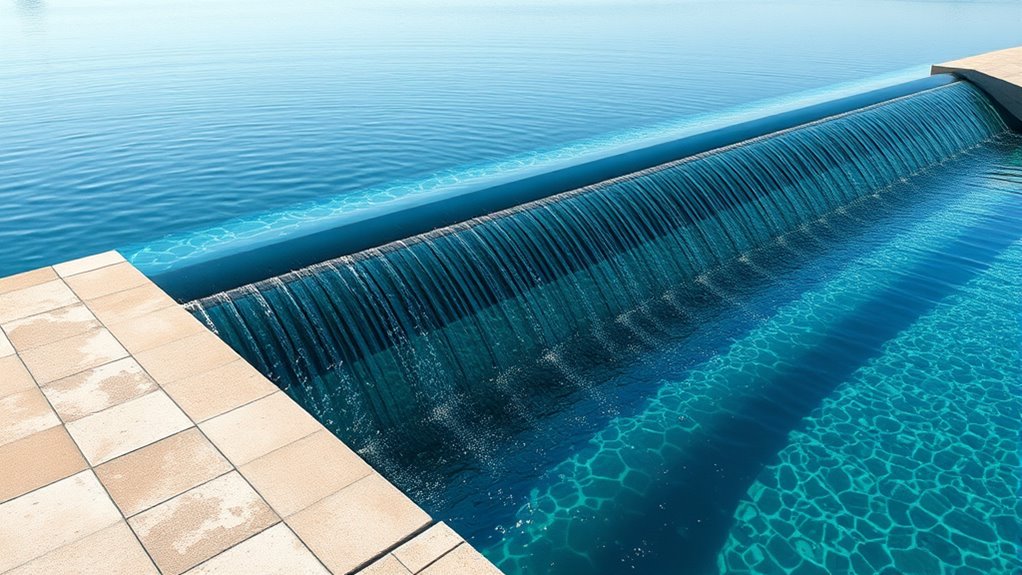
The surge tank plays a vital role in maintaining steady water levels in your pool. It absorbs fluctuations caused by evaporation, rain, or usage, ensuring smooth operation. By understanding how it works, you can better appreciate how water level regulation keeps your pool’s edge looking seamless.
Surge Tank Functionality
A surge tank plays an essential role in maintaining the stability of a vanishing-edge pool’s water level. It acts as a buffer, absorbing fluctuations caused by swimming, evaporation, or rainfall. When water levels rise, the surge tank temporarily holds excess water, preventing overflow or damage. Conversely, if water levels drop, it releases stored water to keep the pool level consistent.
Here are the key functions:
- Absorbs Water Fluctuations: Minimizes sudden changes caused by external factors.
- Prevents Overflow: Contains excess water during heavy inflows.
- Maintains Consistent Water Levels: Ensures a smooth, stable edge appearance and proper water flow.
Water Level Regulation
Water level regulation in a vanishing-edge pool relies on the surge tank to keep the water at a consistent height, ensuring the edge remains visually seamless. The surge tank acts as a buffer, absorbing fluctuations caused by evaporation, rain, or splashing. As water levels rise, excess water flows into the tank, preventing overflows at the edge. Conversely, when water levels drop, the surge tank supplies water back into the pool, maintaining a steady height. This continuous exchange keeps the water at the perfect level for the edge to appear as an endless horizon. The system’s precision prevents unsightly gaps or overspill, preserving the pool’s aesthetic appeal. Proper regulation through the surge tank guarantees your vanishing-edge pool always looks flawless and functions reliably. Additionally, choosing the right filtration system helps maintain water clarity and quality, supporting the surge tank’s effective operation.
Water Circulation and Filtration Systems in Vanishing-Edge Pools
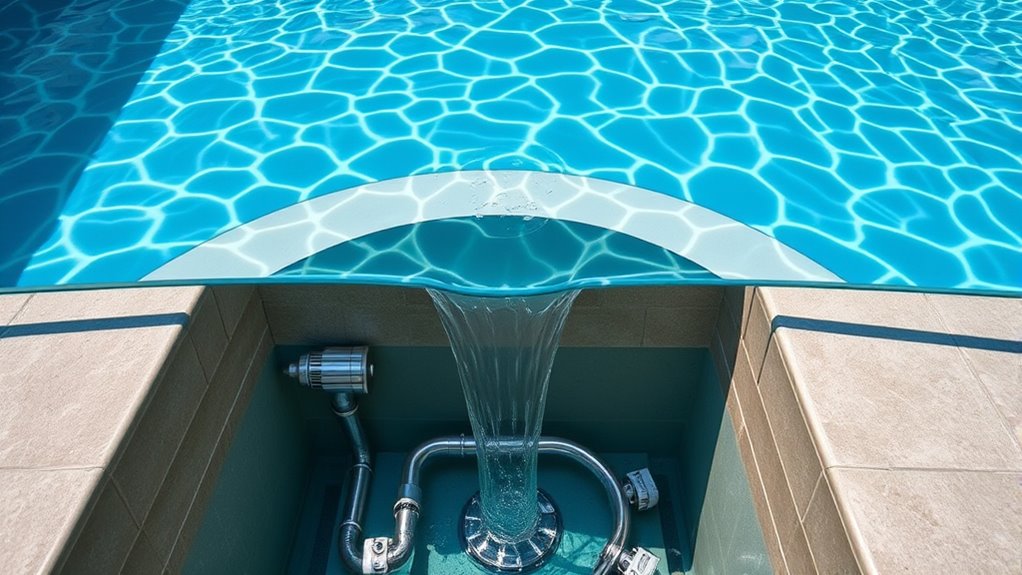
Because vanishing-edge pools rely on precise water movement to create their seamless look, an efficient circulation and filtration system is essential. You need a setup that continuously moves water to prevent stagnation and maintain clarity. A well-designed system also minimizes energy consumption while maximizing performance. Dog breeds are known for their loyalty and intelligence, which can be reflected in the careful design of pool systems to ensure longevity and reliability. 1. Pump System: A powerful, variable-speed pump circulates water constantly, ensuring even flow across the pool surface and over the weir. 2. Filtration: A high-quality filter traps debris and particles, keeping the water crystal clear and preventing clogging of the circulation system. 3. Return Jets: Strategically placed jets direct filtered water back into the pool, promoting smooth circulation and preventing dead zones.
Together, these components work seamlessly to maintain the pool’s aesthetic and functional integrity, ensuring the water remains clean, balanced, and visually stunning.
The Importance of the Overflow Mechanism

The overflow mechanism is essential for maintaining the sleek, seamless appearance of a vanishing-edge pool. It ensures water flows smoothly over the edge without splashes or disruptions, creating that stunning visual effect. By constantly removing excess water, it prevents water levels from rising too high and spilling over unpredictably. This controlled flow also helps protect the pool’s structure and surrounding landscape. Without an effective overflow system, debris and dirt could accumulate at the edge, compromising both aesthetics and water quality. Additionally, it maintains equilibrium between the pool and the surrounding environment, ensuring consistent water levels. Proper installation and maintenance of the overflow system are crucial for optimal performance system efficiency. Ultimately, the overflow mechanism preserves the clean, minimalist look that makes vanishing-edge pools so mesmerizing. It’s a critical component that combines functionality with stunning visual appeal.
Structural Components Ensuring Seamless Water Flow
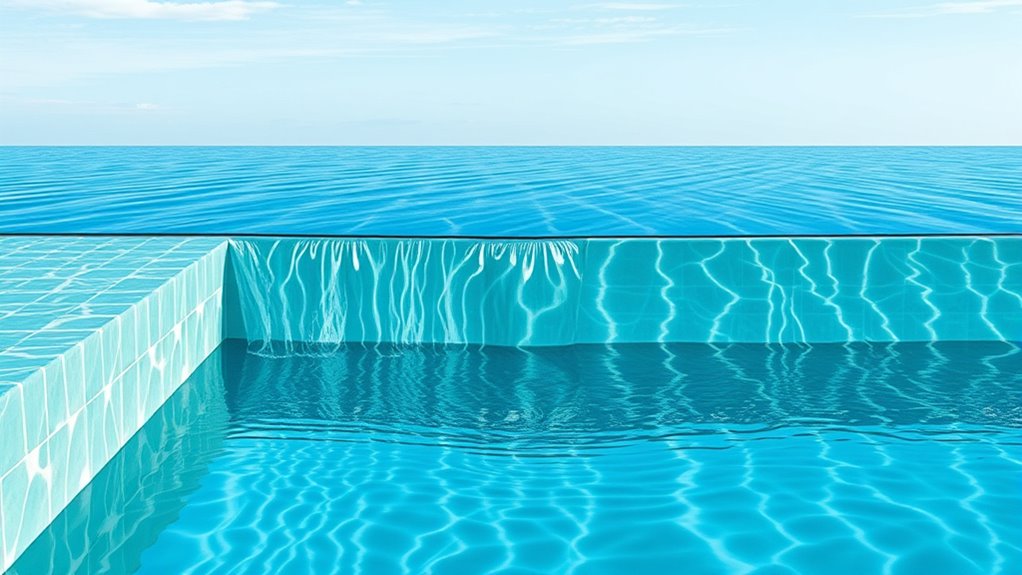
To keep the water flowing smoothly, the design and placement of the weir are vital. Trough water channeling directs flow efficiently, while the surge tank regulates water levels to prevent overflow. Understanding these components helps guarantee your pool maintains a seamless, visually stunning edge.
Weir Design and Placement
Have you ever wondered how a vanishing-edge pool maintains a perfectly seamless water level? The secret lies in the weir’s design and placement. First, you want the weir positioned at the edge of the catch basin, ensuring water flows smoothly over it without turbulence. Second, the weir’s height must be carefully calibrated so that it matches the water level, preventing splashing or overflow. Third, the shape of the weir—whether sharp-crested or curved—affects flow uniformity and aesthetic appeal. Proper placement minimizes turbulence and guarantees water transitions seamlessly into the trough. When designed correctly, the weir acts as a silent gatekeeper, maintaining a clean, consistent edge that creates that stunning vanishing effect you desire. Incorporating water flow management techniques ensures the pool functions efficiently and maintains its aesthetic appeal over time.
Trough Water Channeling
Ensuring seamless water flow across a vanishing-edge pool relies heavily on the design of the trough water channeling system. You need a carefully engineered channel that directs water smoothly from the pool into the catch basin or surge tank. The trough’s shape and material minimize turbulence, preventing splashing or uneven flow. Proper slope and alignment are critical, guiding water at a consistent rate without stagnation. You’ll also want to incorporate smooth, seamless joints to avoid leaks or obstructions that could disrupt flow. The channel’s edges are typically reinforced to withstand constant water movement and environmental stress. When designed correctly, the trough water channeling system ensures a steady, harmonious flow that maintains the aesthetic and functional integrity of your vanishing-edge feature. Additionally, selecting appropriate materials that resist corrosion and environmental wear is essential for long-term performance.
Surge Tank Regulation
A surge tank plays a vital role in maintaining a consistent water flow in a vanishing-edge pool by acting as a buffer that absorbs fluctuations caused by evaporation, splash-out, or pump operation. It helps prevent water level drops or surges that could disrupt the pool’s aesthetic and function. To regulate the surge tank effectively, you should focus on:
- Monitoring water levels regularly to ensure the tank isn’t overfilled or running too low.
- Installing automatic valves that open or close based on water level sensors, maintaining equilibrium.
- Scheduling routine inspections to check for leaks, blockages, or malfunctioning components that could impair regulation.
- Implementing proper structural components like weirs, troughs, and surge tanks, which work together to ensure seamless water flow and protect the pool’s integrity.
Proper regulation guarantees seamless water flow, protecting the pool’s structural integrity and preserving its elegant appearance.
Materials Used in Constructing Weirs, Troughs, and Surge Tanks
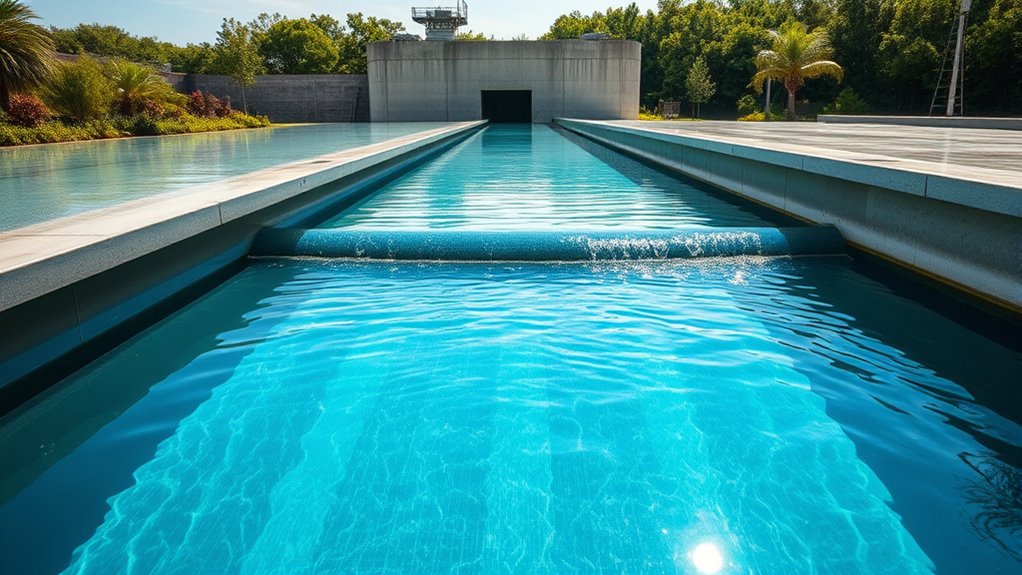
Constructing weirs, troughs, and surge tanks requires selecting materials that are durable, corrosion-resistant, and capable of withstanding constant water exposure. Common choices include concrete, stainless steel, and specialized plastics. Concrete offers strength and longevity but needs proper sealing to prevent leaks. Stainless steel resists corrosion and is easy to maintain, ideal for high-traffic or exposed environments. Plastics like HDPE or PVC are lightweight, flexible, and resistant to chemicals, making them suitable for custom shapes or smaller applications. Here’s a quick overview:
| Material | Advantages | Common Use Cases |
|---|---|---|
| Concrete | Strong, durable, customizable | Troughs, surge tanks |
| Stainless Steel | Corrosion-resistant, sleek | Weirs, structural components |
| Plastics (PVC, HDPE) | Lightweight, chemical resistant | Small troughs, flexible designs |
Common Maintenance Challenges and Solutions
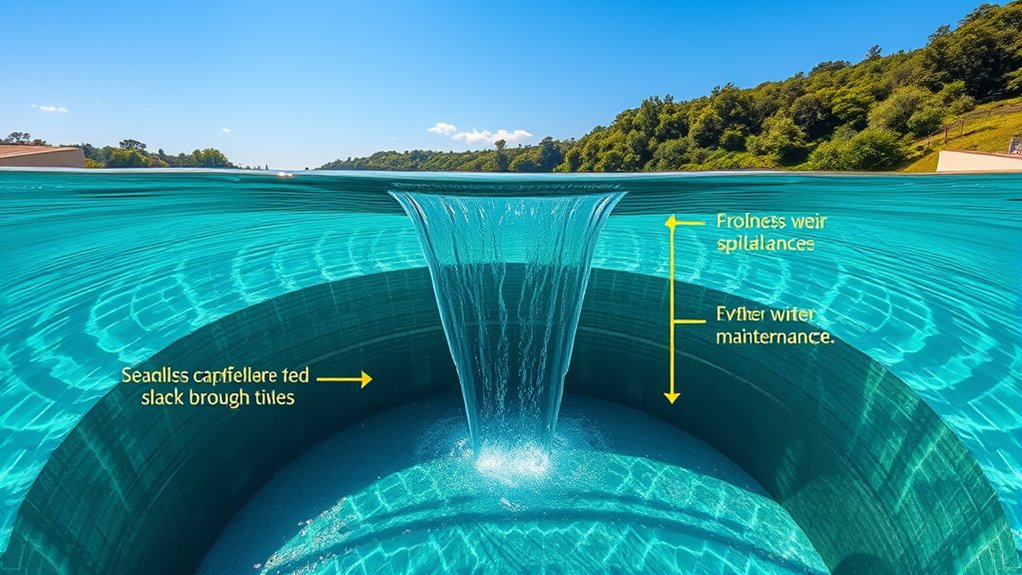
While selecting the right materials for weirs, troughs, and surge tanks helps guarantee their durability, ongoing maintenance presents its own set of challenges. You’ll often face issues like buildup of debris, algae growth, and wear over time. To address these, consider these solutions:
- Regular cleaning of surfaces to prevent debris accumulation and ensure smooth water flow.
- Monitoring and controlling algae through proper filtration and chemical treatments.
- Inspecting for cracks or corrosion periodically, then repairing or replacing damaged parts promptly.
- Implementing digital literacy programs can foster better understanding and maintenance of wearable technology used for safety in vulnerable populations.
Enhancing Safety and Efficiency in Vanishing-Edge Pool Systems
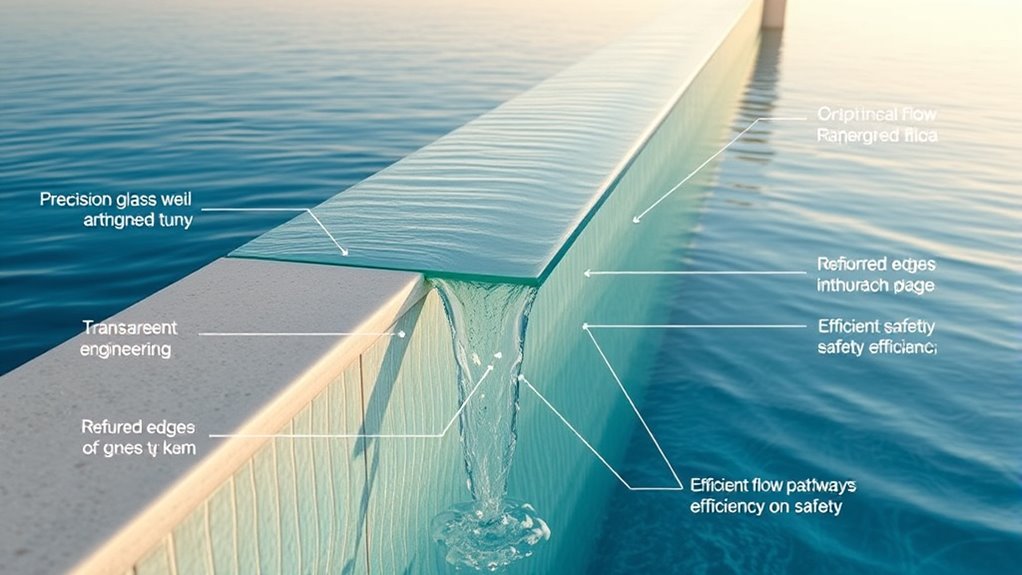
To keep your vanishing-edge pool safe and efficient, you should focus on leak prevention strategies and install overflow monitoring systems. These measures help catch issues early and prevent costly damage. Additionally, having clear emergency response procedures guarantees quick action if problems arise. Incorporating regular maintenance routines can further enhance the longevity and safety of the system.
Leak Prevention Strategies
Leak prevention is crucial for maintaining the safety and efficiency of vanishing-edge pools, as even small leaks can lead to significant water loss and structural damage. To keep your system secure, focus on these strategies:
- Regular inspections of seals, joints, and fittings to catch early signs of wear or damage.
- Using high-quality, corrosion-resistant materials during construction and repairs to ensure durability.
- Implementing a robust leak detection system that monitors water levels and flow rates, alerting you to potential issues immediately.
Overflow Monitoring Systems
Implementing overflow monitoring systems in your vanishing-edge pool is a proactive way to boost safety and optimize performance. These systems continuously track water levels, alerting you if the overflow reaches a critical point. By doing so, you can prevent overflows that might cause water damage or compromise the structural integrity of your pool. Modern sensors and alarms are easy to install and integrate seamlessly with your existing equipment. They provide real-time data, allowing you to respond quickly to fluctuations caused by heavy rain, splash-out, or evaporation. Regular monitoring ensures the overflow system functions correctly, maintaining a safe environment and efficient operation. Ultimately, overflow monitoring systems help you catch potential issues early, saving time, money, and ensuring peace of mind.
Emergency Response Measures
When an emergency arises in your vanishing-edge pool, swift and effective response is crucial to guarantee safety and minimize damage. Your first step is to activate the pool’s emergency shut-off systems to stop water flow immediately. Next, you should:
- Evacuate all individuals from the pool area and alert emergency services if needed.
- Inspect the system for leaks, blockages, or equipment failures that could cause further issues.
- Implement safety barriers or signs to prevent accidental entry until repairs are complete.
Quick action helps prevent water damage, electrical hazards, or structural problems. Regular maintenance and having a clear emergency plan ensure you respond effectively, safeguarding everyone and preserving the system’s integrity.
Frequently Asked Questions
How Do You Prevent Algae Buildup in Vanishing-Edge Pools?
To prevent algae buildup in your vanishing-edge pool, you should maintain proper water chemistry by regularly testing and balancing pH, chlorine, and alkalinity levels. Keep your pool clean by skimming debris and brushing surfaces frequently. Run your pump daily to ensure good circulation, and use a quality algaecide as needed. Also, consider installing a UV sterilizer or mineral system to reduce algae growth naturally.
What Are the Best Materials for Long-Term Durability of Vanishing-Edge Components?
Did you know that high-quality stainless steel can last over 50 years in pool components? For long-term durability, you should choose materials like 316-grade stainless steel for weirs and surge tanks, as it resists corrosion and staining. Additionally, using reinforced concrete or fiberglass for troughs guarantees longevity. These materials withstand weather, pool chemicals, and constant water flow, keeping your vanishing-edge pool looking pristine for decades.
How Does Climate Affect the Operation of Weirs and Surge Tanks?
Climate impacts the operation of weirs and surge tanks considerably. In colder regions, freezing temperatures can cause ice buildup, clogging components and damaging seals. Humid or rainy climates increase corrosion risk, weakening materials over time. Hot, dry climates may lead to evaporation issues and material warping. To guarantee proper functioning, you should select weather-resistant materials, implement regular maintenance, and consider climate-specific design adjustments.
Can Vanishing-Edge Pools Be Customized for Different Landscape Designs?
Yes, you can customize vanishing-edge pools to suit your landscape design. You can choose different materials, shapes, and finishes to match your aesthetic. Incorporate unique features like waterfalls or lighting to enhance the visual appeal. Work with your designer to integrate the pool seamlessly into your outdoor space, ensuring it complements your landscape’s style and environment for a truly personalized and stunning result.
What Are Common Signs of System Failure in Vanishing-Edge Pools?
You should watch for signs like uneven water levels, which indicate a failing weir or pump. If the water isn’t flowing smoothly over the edge, or you notice leaks around the trough or surge tank, these are signs of system failure. Unusual noises from the pump or filter are also warning signs. Address problems promptly to prevent further damage and keep your vanishing-edge pool functioning beautifully.
Conclusion
By understanding how the weir, trough, and surge tank work together, you can appreciate the seamless beauty of a vanishing-edge pool. Some might worry about maintenance or water flow issues, but with proper care, these components keep your pool looking stunning and functioning perfectly. Imagine your pool’s water flowing smoothly over the edge, creating a breathtaking infinity effect that transforms your outdoor space into a luxurious retreat—effortless, elegant, and always mesmerizing.
